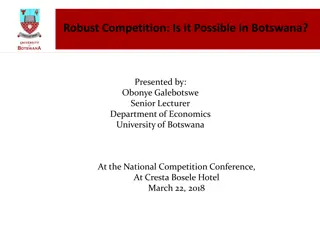Insights on Competition in Healthcare: Lessons from ProMedica and St. Luke's
Competition plays a crucial role in healthcare, with a focus on ensuring that mergers do not harm consumer interests. The Federal Trade Commission highlights the importance of maintaining competition in markets for hospital and physician services. The historical context of government enforcement actions outlines the significance of challenging anticompetitive behavior in the healthcare industry, particularly in preventing price increases resulting from unchecked mergers. Lessons learned indicate the need for a careful review of economic theories, a skeptical approach to efficiency claims, and a keen eye on the impact of mergers on pricing.
Download Presentation

Please find below an Image/Link to download the presentation.
The content on the website is provided AS IS for your information and personal use only. It may not be sold, licensed, or shared on other websites without obtaining consent from the author.If you encounter any issues during the download, it is possible that the publisher has removed the file from their server.
You are allowed to download the files provided on this website for personal or commercial use, subject to the condition that they are used lawfully. All files are the property of their respective owners.
The content on the website is provided AS IS for your information and personal use only. It may not be sold, licensed, or shared on other websites without obtaining consent from the author.
E N D
Presentation Transcript
Competition Matters in Healthcare: Lessons from ProMedica and St. Luke s Thomas N. Dahdouh Regional Director, Western Region Federal Trade Commission
Disclaimer The views expressed are those of the presenter and do not necessarily reflect the views of the Federal Trade Commission or its Commissioners.
Competition is key ACOs are most likely to benefit consumers in markets where their formation does not reduce horizontal competition in the markets for inpatient acute care hospital services, physician services, or any ancillary services. FTC antitrust enforcement experience in challenging anticompetitive combinations shows that this is the wisest approach.
Mixed Record of Government Enforcement Actions Years in the Desert: Courts Reject Antitrust Challenges in Healthcare Freeman (1995) Butterworth (1997) LIJMC (1997) Tenet (1999) Sutter Health (2001) Courts Recognize Importance of Competition in Healthcare Inova (2008) OSF (2012) Reading (2012) Phoebe Putney (2013) St. Luke s (2014) ProMedica (2014)
What happened? Rejection of Economic Theories that Generated Overbroad Geographic Markets Rejection of Assumption that Non-Profit Entities Will Not Exercise Market Power Skeptical Review of Asserted Efficiency Benefits Underlying Concern: Empirical Evidence that Mergers Greenlighted by Courts May Have Led to Price Increases
FTC Merger Retrospective FTC retrospective analysis demonstrated anticompetitive price increases from mergers that courts refused to enjoin. Steven Tenn, The Price Effects of Mergers: A Case Study of the Sutter-Summit Transaction (FTC Working Paper 293) (Nov. 1, 2008)
Old School Geographic Markets: Sutter/Summit Reliance on Elzinga-Hogarty test developed for coal and beer markets Apotheosis of Flow Analysis Retrospective Analysis Demonstrated Inaccuracies. See, e.g. Steven Tenn, The Price Effects of Mergers: A Case Study of the Sutter-Summit Transaction (FTC Working Paper 293) (Nov. 1, 2008) (Distant competitors did not constrain prices; neither did non-profit status of health system)
Insight: Insurers (MCOs), not individual consumers, are the price-setting bargaining entities First-stage versus second-stage competition. First-stage: insurers and providers bargain over price to determine which providers will be in network. Insurer can provide more choices to consumers. Provider gets more access to more customers by being in-network. The more important a provider is to a insurer, the more bargaining power or leverage that provider has. This insight profoundly shifts the analysis from patient flow to the negotiating strength of a firm before and after a merger. Changes geographic market and competitive effects analysis.
The Nonprofit Defense Debunked William Lynk 1995 paper claimed a negative correlation between market power and higher prices when the acquiring firm was a nonprofit. Conclusions strongly criticized at the time. Dranove and Ludwiick article in J. of Health Econ. (1995). Economics literature since then has shown that nonprofits with market power price the same or higher than for-profit health care firms. Town & Vistnes article in J. of Health Econ. (2001); Gaynor & Vogt, RAND J. of Econ. (2003). Judge Posner: adoption of the nonprofit form does not change human nature.
ProMedica: Hospital Merger in Ohio The parties agreed that the geographic market was Lucas County, Ohio. Four hospital providers in Lucas County. ProMedica dominant hospital with 47% of market, followed by Mercy at 29%, University at 13%, and St. Luke s at 11.5%. The FTC argued that the acquisition by ProMedica of St. Luke s would give it a large percentage of the market.
St. Lukes: Physician Group Merger in Idaho St. Luke s Health System, a hospital that owned physician groups in Nampa, Idaho, sought to purchase Saltzer, the largest remaining independent physician group in Nampa. St. Luke s had previously acquired a group of primary care physicians who competed with Saltzer. The FTC argued that, together, the two groups gave St. Luke s 80% of the Nampa primary care physician services market.
St. Lukes: Geographic Market At Issue No major dispute in St. Luke s that Primary Care Physician (PCP) Services was a proper product market. Defense argued that the geographic market was much broader than Nampa, going some 30 miles to the western edge of Boise. FTC focused on Nampa.
Nampa and the Treasure Valley Trial Slide (Dr. Dranove)
The Buyers in St. Lukes were Health Insurance Companies The standard for geographic market is where buyers can turn for alternate sources of supply. (Morgan, Strand v. Radiology, Ltd., 924 F.2d 1484, 1490 (9th Cir. 1991).) the vast majority of health care consumers are not direct purchasers of health care the consumers purchase health insurance and the insurance companies negotiate directly with providers. (Findings, 53 (emphasis added).) St. Alphonsus et al. v. St. Luke s, 2014 U.S. Dist. LEXIS 9264 (Jan. 24, 2014)
Nampa Market confirmed by Payer Testimony and Luke s Testimony and Documents Dr. Dranove: 68% of residents get care locally. Residents getting care outside of Nampa at place of work confirms that patients like to get their medical care close to home. Findings, 65 66. Payers: can t sell product without local Nampa PCPs Findings, 60 62. Luke s: need Saltzer PCPs in order to market itself to employers [in Nampa]. Findings, 63. Luke s Clinic doctor in West Boise (included in defendants market): no competition between Nampa and West Boise. Findings, 68. Findings of Fact & Conclusions of Law (Jan. 24, 2014), ECF No. 464
St. Lukes Competitive Effects Analysis Buyers drive the competitive effects analysis too.
Bargaining leverage depends on substitute physician groups in the market Before the Acquisition: Saltzer PCPs offer an attractive substitute for St. Luke s PCPs, and vice versa The health plan thus has a credible outside option when it negotiates with each provider Health Plan St. Luke s Saint Al s Others Saltzer Entrants? Trial Slide (Dr. Dranove)
Bargaining leverage depends on substitute physician groups in the market After the Acquisition: the health plan loses a credible outside option, and the provider gains negotiating leverage Health Plan St. Luke s & Saltzer Saint Al s Others Entrants? Trial Slide (Dr. Dranove)
St. Lukes and Saltzer Account for Nearly 80% of PCP services in Nampa Market shares for Adult PCP Services in Nampa TX 1789 (Dranove Report), Figure 18 Trial Slide (Governments Closing Arguments) TX 1789 (Dranove Report), Figure 18
HHIs Exceed Presumptively Illegal Thresholds by a Wide Margin Trial Slide (Governments Closing Arguments)
ProMedica Competitive Effects Analysis: focus on how deal changed bargaining leverage of insurers Court found higher prices are explained by greater bargaining leverage vis- -vis insurers Court credited insurers, not ultimate users, as the appropriate buyers. Insurers testified that network without the merging parties that is, with just Mercy and University would not be commercially viable. ProMedica had offered insurers a 2.5 % discount off its rates if the insurer excluded St. Luke s from its network. St. Luke s CEO said: merger with ProMedica has the greatest potential for higher hospital rates and would bring a lot of negotiating clout.
ProMedica Competitive Effects continued Based on this evidence, court found that higher market share leads to higher prices. Court found that the deal would give ProMedica an over 50% share of the market for primary hospital services and a 80% share of the OB market.
ProMedica: Flailing firm defense Court rejected argument that St. Luke s was fatally weakened While it had had financial difficulties pre-merger, it had: recently increased its market share prior to the merger; Had sufficient cash reserves to pay all of its obligations and meet its capital needs without any additional borrowing. Update:ProMedica s cert petition has been denied by the Supreme Court and ProMedica is now planning to divest St. Luke s.
St. Lukes: Defendants Claimed Efficiencies Must Be Merger Specific [E]fficiencies must be merger-specific to be cognizable as a defense. FTC v. H.J. Heinz Co., 246 F.3d 708, 721-22 (D.C. Cir. 2001); see also United States v. H & R Block, Inc., 833 F. Supp. 2d 36, 89; FTC v. ProMedica Health Sys., Inc., No. 11-cv-47, 2011 WL 1219281, at **39-41 (N.D. Ohio Mar. 29, 2011). - Trial Slide (Governments Closing Arguments)
Defendants Could Not Demonstrate Substantial, Merger-Specific Benefits St. Luke s failed to show necessity of employing physicians: while employing physicians is one way to put together a unified and committed team of physicians, it is not the only way. The same efficiencies have been demonstrated with other groups of physicians. (Conclusions, 46.) the efficiencies resulting from Epic and White Cloud [a St.Luke s-sponsored analytics system] are not merger-specific. (Findings, 206.) Findings of Fact & Conclusions of Law (Jan. 24, 2014), ECF No. 464
9th Circuit Concurs but adds that efficiencies must also be competition-enhancing But even if we assume that the claimed efficiencies were merger-specific, the defense would nonetheless fail [St Luke s] did not demonstrate that efficiencies resulting from the merger would have a positive effect on competition. St. Luke s, 778 F.3d 775,792 (9th Cir. 2015)
Emerging Literature that Hospital Purchases of Doctors Do Not Lower Costs or Improve Quality Laurence C. Baker, et al., Vertical Integration: Hospital Ownership of Physician Practices is Associated with Higher Prices and Spending, 33 Health Affairs 756 (2014). John Kralewski, et al., Do Integrated Health Care Systems Provide Lower-Cost, Higher-Quality Care? Physician Executive Journal (PEJ), 14-18 (March/April 2014). This may be because most of the possible cost savings available out there right now in healthcare come from reducing hospital utilization.
Recent Study Supports This Article published in the most recent NEJM by McWilliams, Chernew and Bruce Landon of Harvard examines Medicare spending in Year 1 of the Pioneer ACO program. Pioneer ACOs associated with a 1.2% reduction in Medicare spending as compared to non-Pioneer control group The study finds that Year 1 of the Pioneer ACO program was associated with a modest [1.2%] reduction in Medicare spending. Savings were greater for ACOs with higher baseline spending than for those with lower baseline spending and were unrelated to withdrawal from the program [13 of the original Pioneers withdrew from the program and 19 stayed in)]. Consolidation may not be necessary for ACOs to achieve lower spending Estimated savings were similar in ACOs with financial integration between hospitals and physician groups and in those without such financial integration, suggesting that this form of provider consolidation which could increase bargaining power and prices in commercial markets may not be necessary in order for ACOs to achieve lower spending in Medicare. (pp 7-8)
Antitrust Counseling on Alternatives to Mergers/Acquisitions
Norman PHO Opinion: Good Starting Point FTC, Norman PHO Advisory Opinion (Feb. 13, 2013), at http://www.ftc.gov/policy/advisory- opinions/norman-physician-hospital-organization. Generally regarded as supportive of clinical integration without a merger
Norman: Key Takeaways Geographic Market very small, just a portion of the Oklahoma City CSA. Hospital Market Share over 50% of discharges, but not increased by PHO. Physician Market Share over 50% of all physicians. Key to approval with high physician market shares Non- exclusivity Neither de jure or de facto exclusivity acceptable
Conclusion Competition Matters. Mergers and acquisitions that lead to market power do not benefit consumers and are problematic. We can expect additional new developments, but this is no longer an area where the defense always wins.























